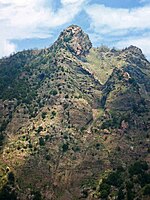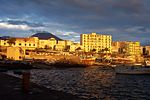Avellino eruption
2nd-millennium BC natural events2nd millennium BCGeography of CampaniaMount VesuviusPlinian eruptions ... and 3 more
Prehistoric volcanic eventsVEI-6 eruptionsVolcanic eruptions in Italy

The Avellino eruption of Mount Vesuvius refers to a Vesuvian eruption in c. 1995 BC. It is estimated to have had a VEI of 6, making it larger and more catastrophic than Vesuvius's more famous and well-documented 79 AD eruption. It is the source of the Avellino pumice (Italian: Pomici di Avellino) deposits extensively found in the comune of Avellino in Campania.
Excerpt from the Wikipedia article Avellino eruption (License: CC BY-SA 3.0, Authors, Images).Avellino eruption
Sentiero n. 4 Parco Nazionale del Vesuvio,
Geographical coordinates (GPS) Address Nearby Places Show on map
Geographical coordinates (GPS)
| Latitude | Longitude |
|---|---|
| N 40.816666666667 ° | E 14.4 ° |
Address
Sentiero n. 4 Parco Nazionale del Vesuvio
Sentiero n. 4 Parco Nazionale del Vesuvio
80040
Campania, Italy
Open on Google Maps









